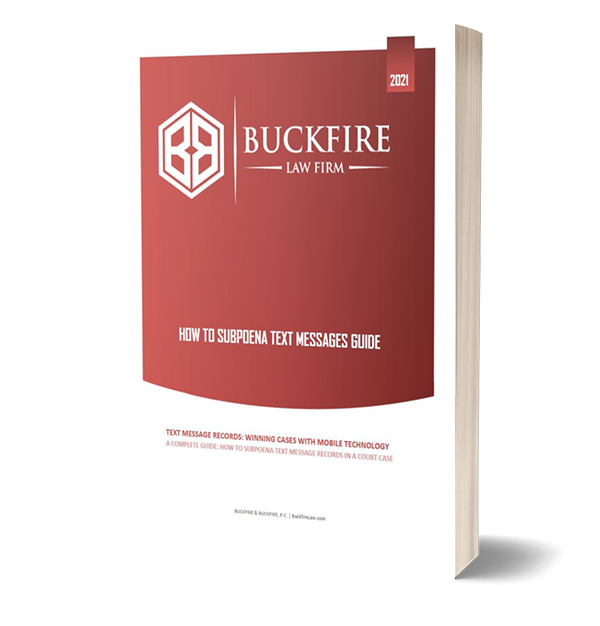
Text messages can provide key evidence in all types of litigated matters. The key is to know when and how to get these messages.
Text Messaging Statistics in the United States
The statistics on text messaging in the United States everyday are staggering. Recent research has shown the following:
- 81% of the American population (259 million people) text every day
- The average person in the U.S. sends 32 texts per day
- More than 781 billion text messages are sent every month
- Greater than 26 billion texts a day,
- More than 9.3 trillion texts a year coming out of the U.S.
The numbers are increasing every year as more businesses, schools, and organizations use text messaging as a primary source of communication.
In addition, these numbers do not include in app messaging, Facebook messages, or the large number of WhatsApp texts sent everyday.
Common Ways to Use Text Messaging in Litigation
Attorneys and litigants can win or lose their case through use of these messages. Our law firm regularly uses these strategies to win big personal injury settlements.
In personal injury cases involving car accidents, motorcycle collisions, and truck crashes, an attorney can discover if a driver was distracted at the time of an accident. Texting while driving is a major cause of motor vehicle crashes in the United States. Many states have specific laws that prohibit a driver from texting in a moving vehicle. Messages and records are also used to show who was contacted by the drivers immediately after the accident, and this can be used to identify potential other fact witnesses.
In cases involving a wrongful death, text messages can be used to show the last words or exchanges just prior to a fatal accident.
In addition, domestic relation attorneys in a contested divorce cases. This can impact property settlements, custody disputes, and parenting time. Text message records can be key evidence in a divorce case when allegations of infidelity are made against one or both of the marital partners.
Business attorneys rely heavily on text communications in commercial litigation cases. Examples are partnership breakups, shareholder disputes, and employment matters. In employment cases, text messages are often the key evidence in cases involving wrongful discharge, sexual harassment, and other types of discrimination cases.
Finally, text messages are also very critical in criminal cases to provide a timeline of events. They can also provide a means and motive, or help to corroborate an alibi. Criminal attorneys can get charges dismissed or win an acquittal at trial with the use of text message records.
How To Get Text Messages by Subpoena
Today, more people communicate through text message than phone calls. Unlike unrecorded phone calls, text messages provide the words of a party.
However, these messages are rarely voluntarily produced by a party or even obtained through basic discovery requests. It is often a battle to get the billing records and actual texts, especially when they are damaging to a party’s cases.
When a party fails to produce the information, the primary option is to serve a subpoena on the cell phone provider. Federal law prevents companies from producing these documents without a court order or subpoena.
Text message records must be obtained from a party’s cell phone provider. An attorney can obtain a court order or subpoena to get the records directly from the service provider. However, there are limitations on what the provider can produce. Federal law makes a distinction between “content of the communication” and “records concerning the communication.”
Typically, cellular service providers maintain records of text message content for a very short period of time. For example, AT&T Wireless converts customers’ SMS cellular signals to internet data stored in its cloud, where it remains for 90 days before being deleted. Once deleted, the content is generally considered lost.
The only possible way to recover lost or deleted text messages by hiring a forensic investigator to inspect the phone. This can be very costly, but it is worth it if important information is obtained. These experts also help lay the necessary foundation for court admissibility at a hearing or trial.
How To Get Our Free Subpoena Text Messages Guide
Text messaging leaves an electronic record of dialogue that can be entered as evidence in court. Like other forms of written evidence, text messages must be authenticated in order to be admitted.
Buckfire Law has published an easy-to-read, how-to guide to help litigators understand the strict compliance procedures. The guide also details important factors and obstacles that a litigator must know when issuing a subpoena for obtaining text messages.
This step-by-step subpoena guide also includes a list of contact information for all major phone carriers, including:
The 16-page FREE subpoena guide reveals:
- How to subpoena text messages
- Requests for customer information
- How to use text records as evidence
- Issues obtaining text message records
- How to serve the subpoena
- Sample spoliation letter
- Cellular telephone subpoena guide
- Sample subpoena form
To receive your free copy of the “How To Subpoena Text Messages” guide, simply fill out a form below.
Once you submit your information, you will be instantly emailed a digital copy of the report. You can download and print it as a great desk reference.
